Ladylike British actress Edna Best (1900-1974) entered films in 1921. She is best remembered as the mother in the original version of Alfred Hitchcock's The Man Who Knew Too Much (1934) and as the second wife of film star Herbert Marshall. She worked both on stage and in the cinema, in the United Kingdom and in the United States.
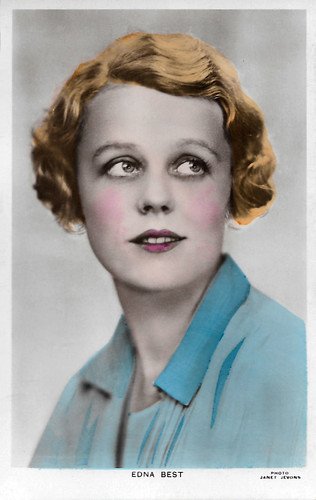
British postcard in the Colourgraph Series, London, no. C. 227. Photo: Janet Jevons.
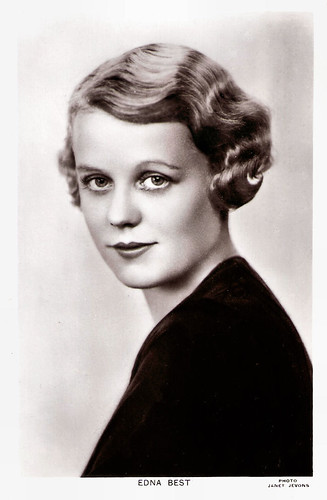
British postcard in the Picturegoer Series, London, no. 631a. Photo: Janet Jevons.
Edna Clare Best was born in in Hove, Sussex, in 1900. She was educated in Brighton and later studied dramatic acting under Miss Kate Rorke who was the first Professor of Drama at the Guildhall School of Music and Drama, London. She also won a silver swimming cup as the lady swimming champion of Sussex.
At the age of seventeen, she made her debut at the Grand Theatre, Southampton, as Ela Delahay in Charley's Aunt (1917). She played Peter Pan three years later and married the first of her actor husbands, Seymour Beard. For a time she played in musical comedies. Her first real London stage hit was in 1925 in the title role of The Constant Nymph opposite Noël Coward, and, subsequently, John Gielgud.
Another stage success was Fallen Angel with Tallulah Bankhead. In The Constant Nymph, she also enjoyed a successful run on Broadway in 1926, which was followed by another Margaret Kennedy play, Come With Me. She married her co-star, Herbert Marshall, after divorcing Beard in 1928.
In 1921 she made her film debut in the title role of the silent comedy Tilly of Bloomsbury (Rex Wilson, 1921) with Henry Kendall and Isabel Jeans. She then starred in the silent drama A Couple of Down and Outs (Walter Summers, 1923). The film sought to raise public sympathy for veterans of the First World War struggling in the years of peace as well as animals who had undergone war service. Director Summers, who had himself served during the conflict, made a number of films using the war as backdrop.
From 1930 on, she appeared in such sound films as Loose Ends (Norman Walker, 1930) with Owen Nares and Miles Mander, a drama made at Elstree Studios. In the crime film Escape (Basil Dean, 1930), she co-starred with Gerald du Maurier and Gordon Harker. Harker played a convict, who escapes from Dartmoor Prison and is hunted across the moors by policemen to whom it is an unpleasant reminder of their experiences during the First World War. It was the first film released by Associated Talking Pictures, a British company with ties to the Hollywood studio RKO, which later relocated and became Ealing Studios. The film was made at Beaconsfield Studios which had been recently equipped for making sound films.
She co-starred with Carlyle Blackwell in Beyond the Cities (Carlyle Blackwell, 1930), a ‘quota quickie’ released by Paramount Pictures. In 1931, she costarred with her second husband Herbert Marshall in the drama Michael and Mary (Victor Saville, 1931), for which they recreated their roles from the London stage. The film, which also starred Elizabeth Allan and Frank Lawton, was voted the third best British film of 1932, and was the first of the Edna Best and Herbert Marshall co-starring talkies. Next they co-starred in the racehorse drama The Calendar (T. Hayes Hunter, 1931) based on a novel by Edgar Wallace, and the drama The Faithful Heart (Victor Saville, 1932).

British postcard by Film Weekly Series, London.
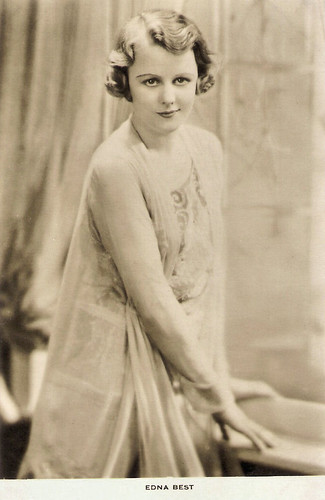
British postcard by Film Weekly Series, London, no. 2.
Edna Best is best remembered for her role as the mother of kidnap victim Nova Pilbeam in the 1934 version of Alfred Hitchcock's thriller The Man Who Knew Too Much, featuring Peter Lorre. It was one of the most successful and critically acclaimed films of Hitchcock's British period.
At the time, The New York Times praised the film as the "raciest melodrama of the new year", noting that it was "excitingly written" and an "excellently performed bit of story-telling". The review praised Alfred Hitchcock as "one of England's ablest and most imaginative film makers”. In a retrospective review, film historian Dave Kehr contrarily argued that "Although the film is fast and consistently clever, it is more deeply flawed than any other Hitchcock film of the period, failing to find a thematic connection between its imaginative set pieces."
Edna Best moved to Hollywood where she appeared in the Pre-Code film The Key (Michael Curtiz, 1934) with William Powell and Colin Clive. The story concerns a love set during the Irish War of Independence. Among her other film credits are Intermezzo: A Love Story (Gregory Ratoff, 1939) with Leslie Howard and Ingrid Bergman, Swiss Family Robinson (Edward Ludwig, 1940), The Late George Apley (Joseph L. Mankiewicz, 1947) with Ronald Colman, and the romantic fantasy The Ghost and Mrs. Muir (Joseph L. Mankiewicz, 1947) starring Gene Tierney and Rex Harrison.
Her final film was the thriller The Iron Curtain (William Wellman, 1948), starring Dana Andrews and Gene Tierney. I.S. Mowis at IMDb: “All in all, Edna's film appearances were few and far between, and only a handful adequately showcased her talents as an actress otherwise so abundantly evident from the body of her work in the theatre.”
From 1939 a U.S. resident and a nationalised citizen by the early 1950s, Best continued her triumphant returns to the stage. Her most celebrated performances on Broadway were in Terence Rattigan's The Browning Version as downtrodden housewife Millie Crocker-Harris and in Harlequinade (1949) and as the titular character Jane (1952) in a play adapted by S.N. Behrman from a W. Somerset Maugham short story.
In 1957, Edna Best received a nomination for an Emmy Award for her role in the TV play This Happy Breed (Noël Coward, Ralph Nelson, 1957). She had appeared on television as early as 1938, in a live production of the play Love from a Stranger, adapted from the Agatha Christie short story Philomel Cottage by Frank Vosper.
Best was married three times and divorced twice. Her first marriage, to William Seymour Beard, ended in divorce in 1928. The London Divorce Court gave Beard custody of the couple's twins (James and John Beard) in granting the divorce "owing to the misconduct of his wife, Miss Best, with Mr. Marshall." The ‘Mr. Marshall’ referred to was actor Herbert Marshall, whose divorce from Hilda Lloyd Marshall ("owing to the misconduct of her husband ... with ... Miss Edna Best") was granted in the same court session.
Later, Best was married to Marshall from 1928, until 1940, and they had a daughter, actress Sarah Marshall. In 1940, Best married talent agent Nat Wolff in Las Vegas, Nevada. The judge who granted the divorce from Marshall after a five-minute closed hearing, performed the marriage a few minutes later. Best suffered a stroke in 1959, the year her husband died. She retired from acting in the early 1960s. In 1974, Edna Best died in a clinic in Geneva, Switzerland, aged 74.

British postcard in the Picturegoer Series, London, no. 71. Photo: Foulsham & Banfield.
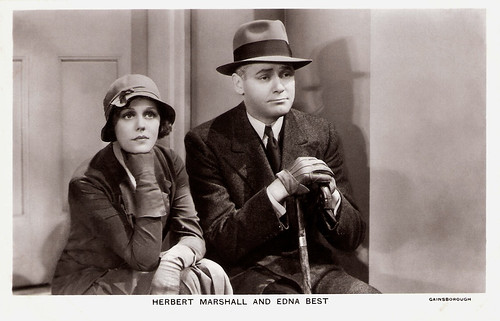
With Herbert Marshall. British postcard in the Film Partners series, London, no. P 72. Photo: Gainsborough.
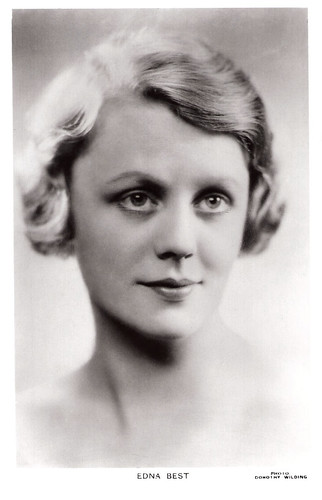
British postcard. Photo Dorothy Wilding.
Sources: I.S. Mowis (IMDb), Los Angeles Times, Wikipedia and IMDb.

British postcard in the Colourgraph Series, London, no. C. 227. Photo: Janet Jevons.

British postcard in the Picturegoer Series, London, no. 631a. Photo: Janet Jevons.
Fallen Angel
Edna Clare Best was born in in Hove, Sussex, in 1900. She was educated in Brighton and later studied dramatic acting under Miss Kate Rorke who was the first Professor of Drama at the Guildhall School of Music and Drama, London. She also won a silver swimming cup as the lady swimming champion of Sussex.
At the age of seventeen, she made her debut at the Grand Theatre, Southampton, as Ela Delahay in Charley's Aunt (1917). She played Peter Pan three years later and married the first of her actor husbands, Seymour Beard. For a time she played in musical comedies. Her first real London stage hit was in 1925 in the title role of The Constant Nymph opposite Noël Coward, and, subsequently, John Gielgud.
Another stage success was Fallen Angel with Tallulah Bankhead. In The Constant Nymph, she also enjoyed a successful run on Broadway in 1926, which was followed by another Margaret Kennedy play, Come With Me. She married her co-star, Herbert Marshall, after divorcing Beard in 1928.
In 1921 she made her film debut in the title role of the silent comedy Tilly of Bloomsbury (Rex Wilson, 1921) with Henry Kendall and Isabel Jeans. She then starred in the silent drama A Couple of Down and Outs (Walter Summers, 1923). The film sought to raise public sympathy for veterans of the First World War struggling in the years of peace as well as animals who had undergone war service. Director Summers, who had himself served during the conflict, made a number of films using the war as backdrop.
From 1930 on, she appeared in such sound films as Loose Ends (Norman Walker, 1930) with Owen Nares and Miles Mander, a drama made at Elstree Studios. In the crime film Escape (Basil Dean, 1930), she co-starred with Gerald du Maurier and Gordon Harker. Harker played a convict, who escapes from Dartmoor Prison and is hunted across the moors by policemen to whom it is an unpleasant reminder of their experiences during the First World War. It was the first film released by Associated Talking Pictures, a British company with ties to the Hollywood studio RKO, which later relocated and became Ealing Studios. The film was made at Beaconsfield Studios which had been recently equipped for making sound films.
She co-starred with Carlyle Blackwell in Beyond the Cities (Carlyle Blackwell, 1930), a ‘quota quickie’ released by Paramount Pictures. In 1931, she costarred with her second husband Herbert Marshall in the drama Michael and Mary (Victor Saville, 1931), for which they recreated their roles from the London stage. The film, which also starred Elizabeth Allan and Frank Lawton, was voted the third best British film of 1932, and was the first of the Edna Best and Herbert Marshall co-starring talkies. Next they co-starred in the racehorse drama The Calendar (T. Hayes Hunter, 1931) based on a novel by Edgar Wallace, and the drama The Faithful Heart (Victor Saville, 1932).

British postcard by Film Weekly Series, London.

British postcard by Film Weekly Series, London, no. 2.
The Man Who Knew Too Much
Edna Best is best remembered for her role as the mother of kidnap victim Nova Pilbeam in the 1934 version of Alfred Hitchcock's thriller The Man Who Knew Too Much, featuring Peter Lorre. It was one of the most successful and critically acclaimed films of Hitchcock's British period.
At the time, The New York Times praised the film as the "raciest melodrama of the new year", noting that it was "excitingly written" and an "excellently performed bit of story-telling". The review praised Alfred Hitchcock as "one of England's ablest and most imaginative film makers”. In a retrospective review, film historian Dave Kehr contrarily argued that "Although the film is fast and consistently clever, it is more deeply flawed than any other Hitchcock film of the period, failing to find a thematic connection between its imaginative set pieces."
Edna Best moved to Hollywood where she appeared in the Pre-Code film The Key (Michael Curtiz, 1934) with William Powell and Colin Clive. The story concerns a love set during the Irish War of Independence. Among her other film credits are Intermezzo: A Love Story (Gregory Ratoff, 1939) with Leslie Howard and Ingrid Bergman, Swiss Family Robinson (Edward Ludwig, 1940), The Late George Apley (Joseph L. Mankiewicz, 1947) with Ronald Colman, and the romantic fantasy The Ghost and Mrs. Muir (Joseph L. Mankiewicz, 1947) starring Gene Tierney and Rex Harrison.
Her final film was the thriller The Iron Curtain (William Wellman, 1948), starring Dana Andrews and Gene Tierney. I.S. Mowis at IMDb: “All in all, Edna's film appearances were few and far between, and only a handful adequately showcased her talents as an actress otherwise so abundantly evident from the body of her work in the theatre.”
From 1939 a U.S. resident and a nationalised citizen by the early 1950s, Best continued her triumphant returns to the stage. Her most celebrated performances on Broadway were in Terence Rattigan's The Browning Version as downtrodden housewife Millie Crocker-Harris and in Harlequinade (1949) and as the titular character Jane (1952) in a play adapted by S.N. Behrman from a W. Somerset Maugham short story.
In 1957, Edna Best received a nomination for an Emmy Award for her role in the TV play This Happy Breed (Noël Coward, Ralph Nelson, 1957). She had appeared on television as early as 1938, in a live production of the play Love from a Stranger, adapted from the Agatha Christie short story Philomel Cottage by Frank Vosper.
Best was married three times and divorced twice. Her first marriage, to William Seymour Beard, ended in divorce in 1928. The London Divorce Court gave Beard custody of the couple's twins (James and John Beard) in granting the divorce "owing to the misconduct of his wife, Miss Best, with Mr. Marshall." The ‘Mr. Marshall’ referred to was actor Herbert Marshall, whose divorce from Hilda Lloyd Marshall ("owing to the misconduct of her husband ... with ... Miss Edna Best") was granted in the same court session.
Later, Best was married to Marshall from 1928, until 1940, and they had a daughter, actress Sarah Marshall. In 1940, Best married talent agent Nat Wolff in Las Vegas, Nevada. The judge who granted the divorce from Marshall after a five-minute closed hearing, performed the marriage a few minutes later. Best suffered a stroke in 1959, the year her husband died. She retired from acting in the early 1960s. In 1974, Edna Best died in a clinic in Geneva, Switzerland, aged 74.

British postcard in the Picturegoer Series, London, no. 71. Photo: Foulsham & Banfield.

With Herbert Marshall. British postcard in the Film Partners series, London, no. P 72. Photo: Gainsborough.

British postcard. Photo Dorothy Wilding.
Sources: I.S. Mowis (IMDb), Los Angeles Times, Wikipedia and IMDb.
No comments:
Post a Comment